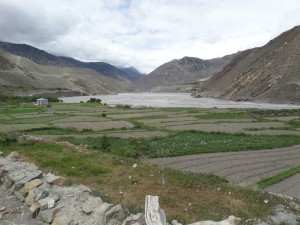Finding Shaligrams is reasonably tricky. In many ways, you need at least a little bit of an idea of what you are looking for before you set out on the silty, rocky, river bed to try your luck. The characteristic inky black color might be hidden under coatings of viscous mud and the patterns of ammonite shell spirals are often worn smooth by millennia of rushing water and aren’t always obvious even from up close. But if searching for a particular kind of stone in a great mountain of stones can be seen as any kind of analogy, I would apply the same idea to walking the narrow streets of Kagbeni village. Sometimes it is hard to know exactly what it is you are looking at, even up close.
Spending time in the village is always a rewarding endeavor. Not only does it give you a sense and feel for how village life is actually carried out, but you also get to play a little Morelli’s Detective while you scour every stupa, mani wall, cross-roads, and threshold for clues as to how people are using and moving through physical and sacred spaces. For example, I note each presence of a Shaligram Stone tucked away inside of Buddhist prayer wheel or set along a wall dividing one part of the village from another. I especially note each time a Shaligram has been placed on the ledge of stupa, often times as an offering to the Dakini of the Himalayas (“Sky Dancers” — powerful female spirits said to inhabit this region). I also carefully log each time I see a goat skull, decorated with spirals and geometric designs, hung over a doorway or a trishula (a marker of Shiva) set in a threshold, or a mani stone, covered in Tibetan mantras, attached to a wall that every traveler must pass. In this region, marking the “spiritual nature” of a space by placing objects and symbols over doorways that represent specific deities, nationalities, and religious traditions is a reasonably common practice, and certainly a helpful one for someone like me.
In this way, each story tells a story, and as confusing as that might sound initially, it comes to make more and more sense as you realize that stories exist in the context of where both you and they are. In other words, stories tell you something about the world in which they come from. Stories are shaped by the landscape, and in turn, shape it; in much the same way as the high winds that perpetually tear through this valley are steered by the mountains and in turn slowly tear the mountains to the ground. So if I may hang on to my analogy a bit longer, then might I say that if each Shaligram Stone that is ever so carefully pulled from all the other river rocks and sand is a story collected from the people of Mustang, then it would do us all a great service to remember that the river was the source of them all.

